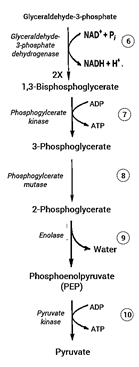Consider the latter half of glycolytic pathway given below:

In reaction 6
I. The enzyme involved is an oxidoreductase
II. Arsenate may uncouple the pathway at this stage
1. Only I is true
2. Only II is true
3. Both I and II are true
4. Both I and II are false

In reaction 6
I. The enzyme involved is an oxidoreductase
II. Arsenate may uncouple the pathway at this stage
1. Only I is true
2. Only II is true
3. Both I and II are true
4. Both I and II are false
Consider the latter half of glycolytic pathway given below:
Regarding reaction 7:
I. Glycolysis has reached the break-even point.
II. When the cell has plenty of ATP (and little ADP), this reaction does not occur.
1. Only I is true
2. Only II is true
3. Both I and II are true
4. Both I and II are false
Refer to the schematic diagram of Krebs citric acid cycle given below:
How many of the enzymes involved in the pathway are dehydrogenases?
1. 2
2. 3
3. 4
4. 5
Refer to the given schematic diagram of Krebs cycle :
The step where substrate level phosphorylation takes place is catalyzed by the enzyme:
1. Aconitase
2. Isocitrate dehydrogenase
3. Succinyl-CoA synthetase
4. Succinate dehydrogenase
When pyruvic acid is converted to acetyl CoA, the former is:
| 1. | Oxidized | 2. | Reduced |
| 3. | Isomerized | 4. | Caboxylated |
A five carbon amino acid can be formed by which of the following intermediates of Krebs cycle?
| 1. | succinate | 2. | malate |
| 3. | citrate | 4. | α-ketoglutarate |
The number of molecules of carbon dioxide produced by three turns of the Krebs cycle would be:
| 1. | 3 | 2. | 6 |
| 3. | 12 | 4. | 18 |
What is the total number of NADH and molecules produced for each molecule of glucose metabolized by glycolysis and the citric acid cycle?
| 1. | 5 | 2. | 6 |
| 3. | 10 | 4. | 12 |
The correct sequence of electron flow during aerobic respiration would be:
1. food → Krebs cycle → ATP → NAD+
2. food → NADH → electron transport chain → oxygen
3. glucose → pyruvate → ATP → oxygen
4. glucose → ATP → electron transport chain → NADH
The components of the mitochondrial electron transport chain are located:
1. in mitochondrial matrix
2. in outer mitochondrial membrane
3. in inner mitochondrial membrane
4. in intermembrane space









